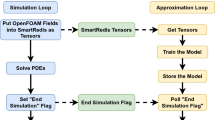Abstract
In this work we propose an adaptive parallel genetic algorithm, which is able to automatically choose which loops should run in parallel in order to balance the workload sharing and the extra cost to manage threads’ forks and joins. Our genetic algorithm finds parameters to our cardiac simulator based on mass–spring systems and cellular automata, in order to reproduce a cycle of contraction and relaxation of the human left ventricle. The ventricle geometry was obtained by extracting information from MRI data. Our multilevel parallelism scheme decreased the execution time up to 12 % and the GA adjusts the cardiac model so that it reproduced a cardiac cycle. The advantages and drawbacks of our method are discussed as well as its limitations.








Similar content being viewed by others
References
Fenton FH, Cherry EM, Hastings HM, Evans SJ (2002) Multiple mechanisms of spiral wave breakup in a model of cardiac electrical activity. Chaos 12:852
Vigmond EJ, Weber dos Santos R, Prassl AJ, Deo M, Plank G (2008) Solvers for the cardiac bidomain equations. Prog Biophys Mol Biol 96(1):3–18
Weber dos Santos R, Plank G, Bauer S, Vigmond EJ (2004) Parallel multigrid preconditioner for the cardiac bidomain model. Biomed Eng IEEE Trans 51(11):1960–1968
Atienza FA, Carrin AG, Alberola JR, lvarez JLR, Muoz JJS, Sichez JM, Chvarri MV (2005) A probabilistic model of cardiac electrical activity based on a cellular automata system. Rev Esp Cardiol 58(1):41–47
Amorim RM, Campos RS, Lobosco M, Jacob C, Santos RW (2012) An electro-mechanical cardiac simulator based on cellular automata and mass-spring models. Lect Notes Comput Sci 7495:434–443
Campos RS, Amorim RM, de Oliveira BL, Rocha BM, Sundnes J, Barra LPS, Lobosco M, Santos RW (2013) 3D heart modeling with cellular automata, mass-spring system and CUDA. Lect Notes Comput Sci 7979:296–309
Campos RS, Lobosco M, Santos RW (2014) A GPU-based heart simulator with mass-spring systems and cellular automaton. J Supercomput 69:1–8
Campos RS, Rocha BM, Barra LPS, Lobosco M, Santos RW (2015) A parallel genetic algorithm to adjust a cardiac model based on cellular automaton and mass-spring systems. Lect Notes Comput Sci 9251:149–163
Pennacchio M, Simoncini ANDV (2011) Fast structured AMG preconditioning for the bidomain model in electrocardiology. SIAM J Sci Comput 33:721–745
Rodrigues PF, Schmal TR, Gomes JM, Rocha BM, Santos RW (2015) Patient-specific left ventricle mesh generation using the Bull’s Eye of the wall thickness measurements from medical images. IFMBE Proc 49:393–396
Koch H, Bousseljot RD, Kosch O, Jahnke C, Paetsch I, Fleck E, Schnackenburg B (2011) A reference dataset for verifying numerical electrophysiological heart models. BioMed Eng 10(1):11 (Online)
Rossi S, Ruiz-Baier R, Pavarino LF, Quarteroni A (2012) Orthotropic active strain models for the numerical simulation of cardiac biomechanics. Int J Numer Method Biomed Eng 28(6–7):761–788
Jarrouse O (2011) Modified mass-spring system for physically based deformation modeling. Ph.D. thesis, Karlsruher Instituts fur Technologie
Bora C, Serinagaoglu Y, Tonuk E (2010) Electromechanical heart tissue model using cellular automaton. Biomedical Engineering Meeting (BIYOMUT), 2010 15th National, pp 1–4
Acknowledgments
The authors thank CAPES, CNPq, FAPEMIG and UFJF for supporting this work.
Author information
Authors and Affiliations
Corresponding author
Rights and permissions
About this article
Cite this article
Campos, R.S., Rocha, B.M., Lobosco, M. et al. Multilevel parallelism scheme in a genetic algorithm applied to cardiac models with mass–spring systems. J Supercomput 73, 609–623 (2017). https://doi.org/10.1007/s11227-016-1798-4
Published:
Issue Date:
DOI: https://doi.org/10.1007/s11227-016-1798-4




